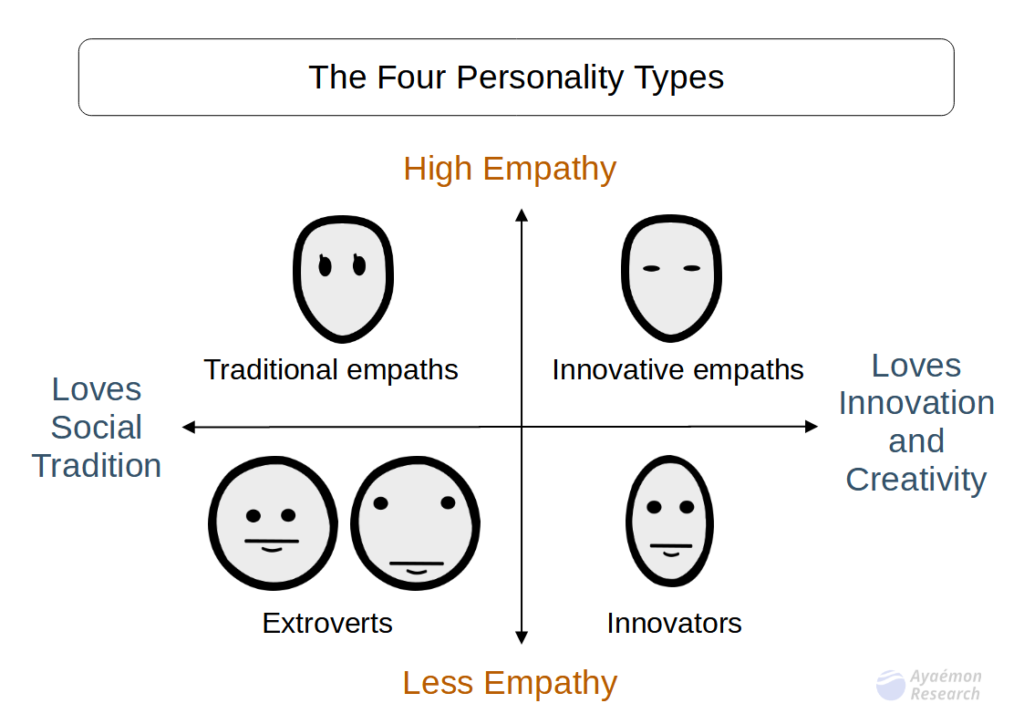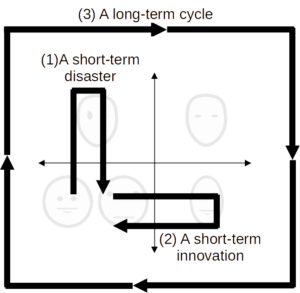In an earlier post (this article), I explained situations in which we can contribute based on our personalities. Today, I will add more explanation. It has a cycle. This knowledge might give us an idea of how to find a more contributable place.
How to find an environment that fits us
Sometimes, we want to make others happy because others’ gladness makes us happy, especially if we have a highly empathic nature. When we help someone, we also feel gratitude for our situation because we can share something valuable with others. That tells us we are abundant in something valuable.
However, it is sometimes hard to do it because we don’t know where to contribute to others. That often causes us to try to work harder that doesn’t suit us, and that makes us exhausted without fulfillment.

In such a case, the cycle of contributable situations might help us. I will explain it below.
The four types of personalities
First, I will explain the four types of personalities that I often use, as follows:

- Extroverts are active people during a stable period. They like to follow social rules. They also like competition and less empathy, so they often begin organized conflicts or wars to keep their gains in many categories if they get poorer. Such conflicts often create some weak people.
- Traditional empaths are active people when with some weaker people during a relatively stable period or a short-term confusing situation. They like to help weaker people. As long as they can rely on the assistance of their community and the number of weak people is manageable, they can be active.
- Innovative empaths are active people when with many weaker people after the stable period ends. They build new ways with their creativity to help a massive number of weaker people. They will show their talent after the community ends its support.
- Innovators are active people after the stable period ends. They create new values or lifestyles according to environmental change. Their creativity helps the whole society and leads to the next stable period.

The periods of contribution
There is a period for those people to contribute, as follows:
- The period of extroverts: The stable period. This period contains small conflicts and a slow up-and-down. The gap between the rich and the poor is stable.
- The period of traditional empaths: The right after a short-term disaster. Although some people are suffering, the whole community can support them. In this period, the gap between the rich and the poor expands.
- The period of Innovative empaths: During a long-term disaster and after the end of community support. Many weak people have to survive on their own without social assistance. This is when almost all people in the community become poorer.
- The period of innovators: The after a long-term disaster or social change. It is when the weak people become few, the gap between the rich and the poor contracts, and the middle-class population increases. Many people improve their lives.

The three types of cycles to contribution
Although there could be many types, I introduce three typical cycles, as follows:

- A short-term disaster: Extroverts period → Traditional empaths period → (Return to the first)
- A short-term innovation: Extroverts period → innovators period → (Return to the first)
- A long-term cycle: Extroverts period → Traditional empaths period → Innovative empaths period → Innovators period → (Return to the first)
This cycle shows us when and where we can contribute.
The contributable situations for the innovative empaths
I will show you an example of an innovative empath here. If we are innovative empaths, we can find some contributable situations.
First, the middle term of a long-term cycle would be the most contributable situation. This is during long-term social crises, such as a disaster, destruction by war, starvation, or climate change. Although many weak people have to survive without social support, they don’t have the creativity to make it possible.
Innovative empaths are the most valuable in this situation because they can break through it with their creativity and empathy.

Next, we can understand that the beginning of a long-term disaster shows us where to contribute soon. It could be a way to check out such a place early.
One of the ideas is finding a large-scale disaster that happened a while ago but that many people have already forgotten. There would be many weak people without social support in such places.
Other contributable situations
Then, we can see that we can contribute with our creativity during the innovators period. Although we seldom use empathy, we can show our creativity to our community.
However, we also understand we will lose our contribution soon because the extrovert’s period follows after that. In other words, when we are in the innovators period, we should be prepared to migrate to another situation.

Finally, the worst period for innovative empaths is the extroverts period. We tend to be useless in this situation. It would be better to change the environment as soon as possible. If it is hard to migrate, we can also enjoy survival life to prepare for the following social confusion.
If you are a traditional empath, you will be active during the short-term disaster or the beginning of the long-term disaster. We can see that the innovator period will be the worst situation for the traditional empaths.
Conclusion
The above is the cycle of contributable situations based on our personalities.
This knowledge might give us an idea of how to find a more contributable place.
Thank you for reading this article. I hope to see you in the next one.


